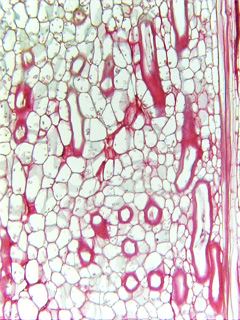 Fig.
9.2-3.
Longitudinal section of spurge stem (Euphorbia). This low magnification
view of spurge shows that the density of laticifers can be very high – a large
percentage of the stem volume is occupied by cells that secrete and store latex.
It would be almost impossible for an animal to bite into this – or to insert
an ovipositor – without running into the secretory product. “Latex” is a
general term, and the species of spurges and milkweeds differ in their
chemistry. Some are quite harmless, but the latex of many can cause your skin to
blister instantly. If
you ever handle a plant that bleeds any kind of visible sap, be careful to avoid
touching your eyes.
Fig.
9.2-3.
Longitudinal section of spurge stem (Euphorbia). This low magnification
view of spurge shows that the density of laticifers can be very high – a large
percentage of the stem volume is occupied by cells that secrete and store latex.
It would be almost impossible for an animal to bite into this – or to insert
an ovipositor – without running into the secretory product. “Latex” is a
general term, and the species of spurges and milkweeds differ in their
chemistry. Some are quite harmless, but the latex of many can cause your skin to
blister instantly. If
you ever handle a plant that bleeds any kind of visible sap, be careful to avoid
touching your eyes.